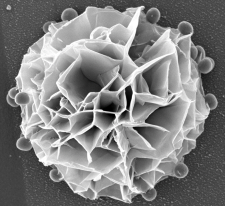NCTR Division of Microbiology
Division Director: Steven Foley, Ph.D.
Deputy Director: Vacant
About the Division
Mission
Serve a multipurpose function including evaluating the impact of antimicrobial agents, food contaminants, food additives, nanomaterials, and FDA-regulated products on the microbiome; developing methods to detect and characterize microbial contaminants; determining antimicrobial resistance and virulence mechanisms; conducting research to aid FDA in the areas of women's health, tobacco products, and nanotechnology; and improving risk assessments.
FDA Grand Rounds: The Plasmid Puzzle—Finding Solutions in Salmonella
Presented by Kristina Feye, Ph.D.
Watch the Recorded Presentation
2023 Select Accomplishments
Developing a Plasmid Analyses Toolbox
FDA Grand Rounds: The Plasmid Puzzle—Finding Solutions in Salmonella
Presented by Kristina Feye, Ph.D.
Watch the Recorded Presentation
NCTR collaborated with CVM scientists to develop tools and approaches to cure bacterial plasmids—genetic structures outside of the bacteria’s chromosome that often carry genes encoding for AMR and/or virulence traits—and specifically remove plasmid genes to identify their functions related to virulence and AMR.
These efforts will help researchers better understand the factors that increase the ability of resistance plasmids to be shared among bacteria spreading AMR. Recent publications describing this work are available in the journals, BMC Genomics, Front Microbiol, and Microbiology Spectrum.
Using Biofilm Models to Study AMR
Biofilm-associated infections associated with implanted medical devices is a major challenge and public health concern. During treatment, bacterial cells in biofilms may be exposed to sublethal concentrations of the antimicrobial agents which can drive antimicrobial resistance development. These studies demonstrate that global protein expression differences within biofilms following antibiotic pressure may improve our understanding of the mechanisms of antibiotic resistance in biofilms. A recent publication describing this work is available in the journal, Pathogens.
Surveying Microbial Contaminants in Commercial Tattoo Inks and Other Related Products
Tattooing and the use of permanent makeup inks have dramatically increased over the last decade. It is estimated that between 20-30% of the U.S. population have at least one tattoo. The process of tattooing involves the injection of different inks into the skin, thereby breaking the epithelial layer that serves as a protection from infection. If inks used for tattooing contain microorganisms, there is the chance for infections to develop. This research found that microbial contamination in commercial tattoo inks and related products is not rare and might be potential sources of human infections, presenting a significant public health concern. With the growing tattoo industry and the global supply chains for tattoo inks, a deep understanding of the microbial contamination in these products is important. A recent publication describing this work is available in the journal, Front Public Health.
Completed Projects
- An assessment of the interactions of nanoscale (TiO2 and ZnO) materials used in sunscreens on the skin microbiome
- Studies on the intrinsic structural multidrug efflux pump mechanisms in antimicrobial resistant Salmonella enterica and their role in antimicrobial resistance
- Anaerobic bacterial detection in tattoo inks and other related products
Ongoing Projects
- Standardized methods for sporicidal efficacy assessment and building up an efficacy database of sporicidal products
- Safety assessment of nanocrystal drug to determine effects on the gastrointestinal tract microbiome and functions
- Recombinant coronavirus spike proteins to generate reagents, study cell interactions, and antibody-dependent enhancement
- Evaluation of antimicrobial, antibiofilm and cytotoxicity activity of nanoparticles, and nanostructured surfaces
Collaborations
- 11 collaborations with other NCTR divisions
- 15 collaborations with other FDA centers
- 5 collaborations with outside entities (non-FDA)
Resources for You
- Division of Microbiology Fact Sheet
- NCTR Grand Rounds: "The Plasmid Puzzle—Finding Solutions in Salmonella" (Presentation recorded in Zoom on July 13, 2023)
- NCTR Grand Rounds: "Studies of SARS-CoV-2 NSP1 and Envelope Protein" (Presentation recorded in Adobe Connect on March 11, 2021)
- Annual Report
- Meet the Principal Investigators
- About the National Center for Toxicological Research
Contact Us
- NCTR
- National Center for Toxicological Research
Food and Drug Administration
3900 NCTR Rd
Jefferson, AR 72079
-
Hours Available
- NCTRResearch@fda.hhs.gov
- (870) 543-7121

